AMPLIFY VOL. 36, NO. 11

Around the world, efforts are increasing to drastically reduce greenhouse gas (GHG) emissions by 2050. The goal of the Paris Agreement is to hold the increase in global average temperature rise to below 2°C as compared with preindustrial levels, specifically aiming to limit it to 1.5°C. As of 2017, the global average temperature rise reached approximately 1°C. It is expected to hit the 1.5°C mark by 2040 if current trends continue. Limiting temperature rise to 2°C will require reaching net zero emissions in the latter half of the 21st century; GHG emissions would need to reach a near-zero value by 2050 to limit the rise to 1.5°C.1
The industrial sector represents a significant source of energy-related GHG emissions. For instance, in the US, it accounted for 33% of overall primary energy use in 2020 and was responsible for 30% of the nation’s total energy-related GHG emissions (see Figure 1).2 Reducing a sizeable portion of these emissions will play a key role in achieving the Paris Agreement’s goals.
![Figure 1. Carbon emissions and primary energy use by sector, 2020 (source: US Energy Information Administration [EIA])](/sites/default/files/Amplify/2023/amp2311_oakridge_F01_0.png)
The focus of industrial decarbonization is on the energy-related CO2 emissions from fossil fuel combustion and specific processes, since they constitute the largest portion of industrial GHG emissions. Other GHGs, such as CH4 and N2O, have higher global-warming potential and should be reduced as well, but they are comparatively less in amount.
As of 2021, manufacturing was responsible for almost three-quarters of all industrial GHG emissions in the US.3 The bulk of manufacturing energy-related CO2 emissions comes from iron and steel, chemicals, food and beverage, petroleum refining, pulp and paper, and cement (see Figure 2). Decarbonization efforts should therefore focus on these industries.
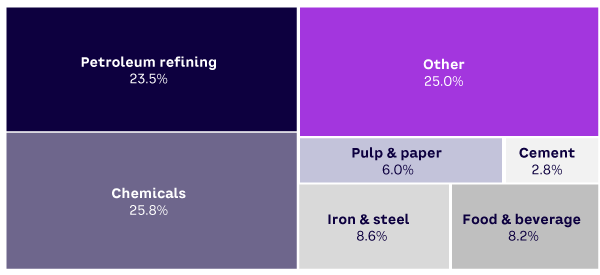
(source: EIA)
Over the past several years, strategies such as reducing carbon-intensive processes, switching from coal to gas and renewables, and increasing efficiency have been adopted by many industries to reduce energy intensity and related emissions. The US Department of Energy’s (DOE) Industrial Decarbonization Roadmap identified four pillars as viable pathways to industrial decarbonization: (1) energy efficiency; (2) industrial electrification; (3) low-carbon fuels, feedstocks, and energy sources (LCFFES); and (4) carbon capture, utilization, and storage (CCUS) (see Figure 3).4
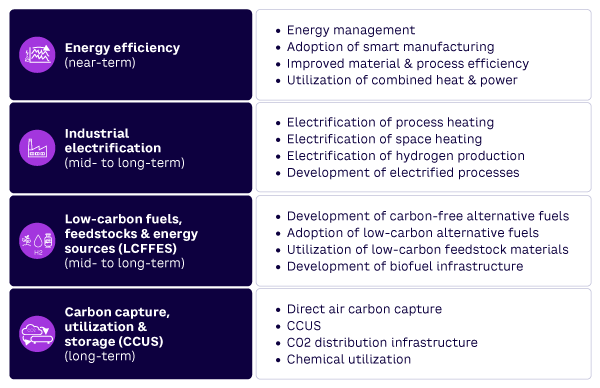
The energy-efficiency pillar focuses on lowering energy demand to reduce CO2 emissions from fossil fuel combustion. The industrial electrification pillar focuses on using electricity to replace the direct combustion of fossil fuels and lower the carbon intensities of both grid and on-site electricity-generation sources. The LCFFES pillar can further lower emissions associated with fossil fuel combustion by substituting fossil fuels, feedstocks, and energy sources with low- and no-carbon alternatives. Finally, the CCUS pillar aims to capture difficult-to-abate CO2 emissions at the source or directly from the atmosphere. Captured CO2 emissions can be used or stored for longer periods to prevent them from entering the atmosphere.5
To achieve net zero emissions by 2050, the US industrial sector must decarbonize by adopting emerging and transformative technologies like electro-technologies, LCFFES, and CCUS and by focusing on energy-efficiency efforts. Although almost half of the emissions reductions in 2050 are expected to come from transformative technologies, most emission reductions through 2030 would come from energy-efficiency technologies already available and proven effective.
In total, 66% of the on-site manufacturing sector’s CO2 emissions are from process energy use and are mostly attributable to process heating, steam, and motor-driven systems.6 Energy efficiency remains the most cost-effective option to reduce these GHG emissions. However, with the emergence of other decarbonization strategies, energy efficiency has recently taken a back seat for many manufacturers, especially in energy-intensive sectors. The surplus of oil and gas in the US, coupled with low natural gas pricing, is also making energy efficiency a lower priority.
To strengthen the role of energy efficiency in decarbonization, the industrial sector needs to better understand the approaches it can leverage. This article addresses this knowledge gap and details energy-efficiency opportunities for the industrial sector in general and the six most energy-intensive industries.
Our 2023 paper featured in “Renewable Energy Systems and Energy Efficiency for a Decarbonized Sustainability,” a special issue of Sustainability, provides a thorough literature review of studies across the globe addressing energy efficiency’s potential to reduce carbon emissions in these industries and the industrial sector in general.7 This article serves as a preliminary guide to support the selection of specific energy-efficiency technologies.
Energy Efficiency for Industrial Decarbonization
Energy-efficiency improvement is a feasible, low-cost approach that, in most cases, does not require any major change to industrial processes and can bring immediate emissions reductions. Since 2010, through the Better Buildings, Better Plants program, DOE has worked with more than 270 manufacturers and water and wastewater utilities across the US to accelerate the adoption of energy-efficient practices, highlight innovative technologies, and spur change at an organizational level.
Through the program, DOE supports 3,600 facilities, corresponding to 14% of US manufacturers. Collectively, these firms have reported savings of 2.2 quadrillion BTUs (British thermal units) of energy. That is equivalent to 131 million metric tons (MMT) of CO2 emissions reductions and a savings of US $10.6 billion.8
Figure 4 shows the average energy-intensity improvement in terms of the number of plants and the program’s energy footprint for selected sectors since 2010. Current energy-efficiency measures in the US industrial sector can potentially save 6.25 quads of energy (6.5% of baseline energy use in 2050) and reduce CO2 emissions by 244 MMT (5.6% of baseline energy CO2 emissions in 2050) through 2050.9
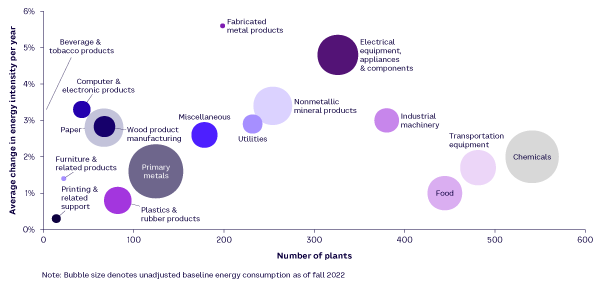
Similar studies have been conducted around the world. In 2015, the UK government released a series of reports that assessed the potential for a low-carbon future and developed decarbonization roadmaps for eight of the UK’s most heat-intensive industrial sectors.10 Per the study, combined max tech pathways (CCUS, electrification, material efficiency, energy efficiency, and other approaches) can reduce emissions from 81 MMT CO2 in 2012 to 22 MMT CO2 in 2050. Energy efficiency combined with heat recovery alone potentially contributes to a reduction in total emissions of 8 MMT CO2 (13% of the overall reduction) in 2050. The main contributors to emissions reductions are the refining industry (43%), the pulp and paper industry (41%), and the food and beverage industry (36%).
Similarly, industrial energy consumption in the EU is projected to drop by 25% in 2050 compared to 2015 levels through energy-efficiency improvements, with waste heat–recovery applications as the primary driver. The energy-efficiency improvements are also expected to reduce energy-related CO2 emissions by 22% in iron and steel sectors, 22% in chemical sectors, 35% in the nonmetallic minerals (e.g., cement, lime) sector, 15% in the nonferrous metals sector, and 32% in refineries in 2050 compared with the baseline scenario.11 In Australia, energy efficiency in the manufacturing sector could cause a 40% reduction in energy intensity by 2050 compared to 2010 levels.12
The following sections describe specific strategies for achieving energy efficiency. (For further details, see “Energy Efficiency as a Foundational Technology Pillar for Industrial Decarbonization,” which includes informative tables showing energy-efficiency strategies for the six most energy-intensive sectors.)
Strategic Energy Management
Strategic energy management is a systematic approach that empowers an organization with continual energy management practices. It supports energy and emission reductions by providing the tools necessary to integrate energy management into a facility’s daily operation. There are three vital elements to strategic energy management: the organization’s commitment, the identification and implementation of energy-efficiency projects, and the tracking and reporting of performance.13 Strategic energy management also includes using energy management information systems and adopting energy management standards and protocols (e.g., ISO 50001). DOE has developed 50001 Ready Navigator for manufacturers, an online application that provides step-by-step guidance for implementing and maintaining an energy management system in conformance with ISO 50001.14
System Efficiency
The energy efficiency of industrial systems can be improved by evaluating the performance of energy end uses (e.g., process heating, process cooling, steam, compressed air, pumps, fans, and other systems) and taking action to reduce energy consumption. Some of the highest energy-use requirements come from a few systems. Process heating (fuel-based, steam-based, and electricity-based) and machine drives play a dominant role and are responsible for more than 77% of total energy use and 60% of total emissions in the US manufacturing sector (see Figure 5).
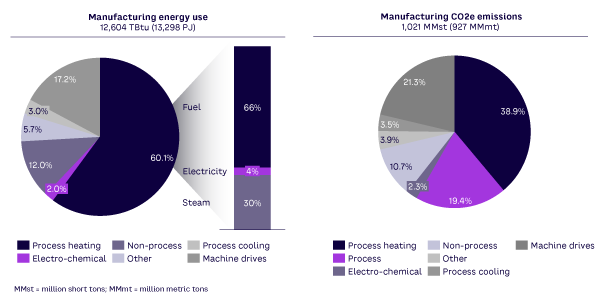
Process-heating operations (heating, melting, curing, heat treating, drying, and smelting) are essential to a number of industries. A variety of process-heating equipment (e.g., furnaces, ovens, dryers, kilns, and incinerators) operate under the same principle of transferring thermal energy from fuel combustion directly or indirectly to the load or the material. Thus, using high-efficiency systems provides significant savings in energy and CO2 emissions. For example, a high-efficiency boiler can deliver 350 trillion BTUs of energy savings and a 20 MMT CO2 reduction annually in the US.15
In 2018, process-heating systems used 7,576 trillion BTUs of primary energy, contributing to about 360.4 MMT of CO2-equivalent (CO2e) GHG emissions in the US manufacturing sector.16 Most of the energy-savings opportunities in process heating are reducing, recycling, and recovering waste heat losses.
In 2006, DOE initiated Save Energy Now assessments to evaluate the energy efficiency of industrial steam and process-heating systems in energy-intensive US facilities.17 The results from assessments conducted between 2006 to 2011 indicated that process-heating and steam systems combined could save approximately 480,000 million BTUs per plant per year, a CO2-reduction potential of about 31,000 metric tons per plant per year, with most of the savings coming from the recovery and reuse of waste heat.
Motors and machine drives (e.g., pumps, fans, and compressors) are used in a wide variety of manufacturing applications, including fluid handling, material handling, processing, and HVAC systems. Industrial motors and machine drives accounted for about 17% of US manufacturing’s total energy use and 21% of carbon emissions (see Figure 5). Inappropriate equipment sizing and poor system design result in inefficiency, increased maintenance, reduced control, and decreased energy performance.18 These inefficiencies can be countered by using high-efficiency or premium-efficiency motors, installing adjustable speed drives, power conditioning, developing better system designs, and properly sizing equipment.19
In addition, matching drive systems (pumps, fans, and compressors) with end-use requirements will reduce energy use. The implementation of energy-efficiency technologies for industrial motor drives in six countries showed an average potential of 28%-38% energy savings compared to the 2008 electricity use of these systems; the potential electricity savings were found to be 25%-35% in the US.20 Optimizing performance, regular system maintenance, continuous monitoring, and upgrading ensure highly efficient systems and lower energy consumption and carbon emissions.
Material & Lifecycle Efficiency
Material and lifecycle efficiency involves using less material to produce the same set of products, extending the life of a product, and increasing product utilization rates without compromising the end-use benefits of the product. Material efficiency, additive manufacturing, material substitution, and a circular economy (CE) are crucial to reducing material waste, energy demand, and GHG emissions in the manufacturing sector.
Heavy industries, such as iron/steel and cement, are leading contributors to global industrial-process CO2 emissions and can benefit significantly from material efficiency, especially since demand is expected to increase by 12% to 23% for cement and 40% for steel by 2050.21,22 Material efficiency can lead to significant CO2 emissions reduction by 2060, potentially reducing the total emissions by approximately 20% for steel, 70% for cement, and 30% for aluminum.23
In a circular economy, a material’s end of life is extended by reuse, remanufacturing, repair, or refurbishment, followed by recycling and clean disposal when the material can no longer be circulated across its lifecycle. CE strategies can be used to enable decarbonization, increase resource productivity, ensure sustained access to scarce resources, and extend the economic value of materials and products.
The Ellen MacArthur Foundation estimates that a CE approach can reduce global CO2 emissions from cement, steel, plastics, and aluminum by 40% annually by 2050. Waste elimination accounts for 24% of the emission reduction, and extending lifetimes by reusing and recirculating the material accounts for 30% and 50%, respectively.24 In Europe, the CE model is expected to reduce emissions by 56% annually until 2050 in energy-intensive sectors.25
Smart Manufacturing
Implementing smart manufacturing technologies can create energy savings through improved process control, reduced waste, a shorter downtime, and improved performance and productivity. Smart manufacturing involves using advanced sensors, monitoring and control systems, and optimization technologies to gather and process data and provide actionable insights to manufacturing personnel while improving decision-making across facilities and supply chains. Big data, the Industrial Internet of Things, and machine-to-machine communications are all driving forces for smart manufacturing. The benefits of smart manufacturing include reduced cost, production flexibility, shorter time to market, greater energy efficiency, reduced environmental impact, and increased productivity.26
DOE estimates average energy savings of more than 20% across all industries based on a review of several sets of studies.27 The feasibility of smart manufacturing technologies depends on several factors, such as energy use, capital, operations and maintenance costs, increased revenue from increased productivity, education and training, cybersecurity, and energy savings. Smart manufacturing feasibility for energy productivity can be determined using the cost of a conserving energy framework, which balances some of these factors against changes in energy use.
Combined Heat & Power
Combined heat and power (CHP) generates electricity or mechanical power and captures the heat that would have otherwise been wasted to provide valuable thermal energy.28 CHP is a type of distributed generation located at or near the point of use. CHP improves efficiency and reduces GHG emissions by reducing or replacing the purchase of electricity from the grid and thermal energy produced by boilers, typically fueled by natural gas. In addition, electricity generated by CHP does not have any transmission and distribution losses, unlike conventional electricity generation.
CHP systems have been used to generate electricity for decades and continue to be relevant as industries seek to reduce their environmental impact while maintaining a reliable energy supply with high efficiency and low emissions. Industrial CHP systems, through both topping and bottoming cycles, can provide needed energy services for some sectors with overall energy efficiencies of 65%-85% (compared to the separate production of heat and power, which collectively average to 45%-55% system efficiency).29
CHP has historically relied on fossil fuels, but newer CHP technologies use low-carbon fuels like biogas, renewable natural gas, and hydrogen, which can further reduce GHG emissions. Renewable natural gas and hydrogen CHP systems can be a long-term path to decarbonizing industrial thermal processes that are resistant to electrification because of technology or cost barriers, as well as critical operations where dispatchable on-site power is needed for resilience and reliability.
Energy Efficiency for Energy-Intensive Industrial Sectors
The majority of industrial emissions come from energy-intensive sectors. DOE’s Advanced Manufacturing Office (AMO) conducted energy-bandwidth studies to analyze energy use and potential energy savings for selected manufacturing sectors (see Figure 6).30
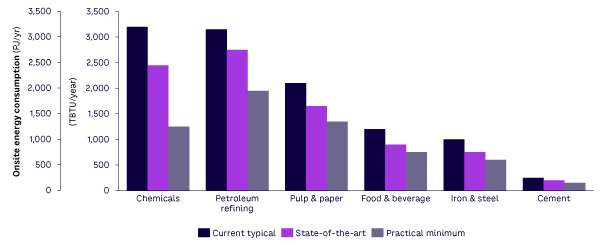
As identified in a French report on this subject, energy-intensive industries have traditionally been difficult to decarbonize due to the difficult-to-abate, fossil fuel–driven, expensive process-heating infrastructure.31 As a result, they have been reluctant to join government decarbonization programs. Figure 7 shows the results of a brief review of programs around the world for decarbonizing the industrial sector.
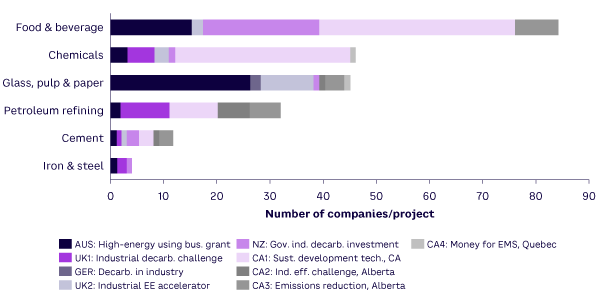
The uptake of these programs was dominated by the food and beverage industry — to the point where the Australian government launched a separate program focused on this sector. Canadian programs have seen petroleum-refining industries participate more frequently than in other parts of the world, which can be attributed to Canada’s unique sector-specific characteristics.
Iron and steel industries had relatively less participation. These results can be leveraged further to identify the reasons behind the reluctance in participation and to develop programs catered toward specific sectors. For a table showing details on these programs, please see “Energy Efficiency as a Foundational Technology Pillar for Industrial Decarbonization.”
Government-backed programs are focused not only on funding, but also on providing technical assistance and various types of assessments. In fact, compared with the larger investments in electrification, switching to low-carbon fuels, and CCUS, energy-intensive industries seem to be enthusiastic about implementing energy-efficiency projects.
Conclusion
The industrial sector plays a crucial role in many economies, and decarbonizing it can lead to significant emissions reductions. If the US and other countries are to achieve their long-term climate goals, immediate action must be taken to decarbonize manufacturing.
This article describes the potential of the energy-efficiency technology pillar and its pathways for decarbonizing the industrial sector, with special attention paid to energy-intensive industries. It shows how energy-efficiency strategies implemented at the system and process level can bring both short-term and long-term reductions in carbon emissions.
Acknowledgments
The submitted manuscript was prepared by Oak Ridge National Laboratory (ORNL), which is managed by UT-Battelle for the US Department of Energy (DOE) under contract DE-AC05-00OR22725. The authors gratefully acknowledge the support of the DOE’s Industrial Efficiency & Decarbonization Office. The authors also thank Arman Shehabi (Lawrence Berkeley National Laboratory), Alberta Carpenter (National Renewable Energy Laboratory), Sarang Supekar (Argonne National Laboratory), and Prakash Rao (Lawrence Berkeley National Laboratory), who provided valuable insights during the research and analysis process. The authors also thank Olivia Shafer of ORNL who assisted in the development and review of this article.
Funding: This work was funded by the DOE’s Industrial Efficiency & Decarbonization Office’s Strategic Analysis project. Research supported by the Office of Energy Efficiency and Renewable Energy (EERE), Advanced Manufacturing Office (AMO), and the DOE under contract DE-AC05-00OR22725, ORNL, managed and operated by UT-Battelle.
References
1 Rissman, Jeffrey, et al. “Technologies and Policies to Decarbonize Global Industry: Review and Assessment of Mitigation Drivers Through 2070.” Applied Energy, Vol. 266, May 2020.
2 “Annual Energy Outlook 2021.” US Energy Information Administration (EIA), accessed November 2023.
3 ”Annual Energy Outlook 2022: Table 19. Energy-Related Carbon Dioxide Emissions by End Use.” US Energy Information Administration (EIA), accessed November 2023.
4 Cresko, Joe, et al. “Industrial Decarbonization Roadmap.” US Department of Energy (DOE), September 2022.
5 Cresko et al. (see 4).
6 Industrial Efficiency & Decarbonization Office. “Manufacturing Energy and Carbon Footprints (2018 MECS).” US Office of Energy Efficiency & Renewable Energy (EERE), accessed November 2023.
7 Sundaramoorthy, Senthil, et al. “Energy Efficiency as a Foundational Technology Pillar for Industrial Decarbonization.” Sustainability, Vol. 15, No. 12, June 2023.
8 “2022 Better Plants Progress Update.” Better Buildings, Better Plants, US Department of Energy (DOE), 19 September 2022.
9 Ungar, Lowell, and Steven Nadel. “Halfway There: Energy Efficiency Can Cut Energy Use and Greenhouse Gas Emissions in Half by 2050.” American Council for an Energy-Efficient Economy (ACEEE), 18 September 2019.
10 WSP/Parsons Brinckerhoff/DNV GL. “Industrial Decarbonisation & Energy Efficiency Roadmaps to 2050: Cross-Sector Summary.” UK Department of Energy and Climate Change/Department for Business, Innovation and Skills, March 2015.
11 “A Clean Planet for All: A European Long-Term Strategic Vision for a Prosperous, Modern, Competitive and Climate Neutral Economy.” European Commission, 28 November 2018.
12 Denis-Ryan, Amandine, et al. “Pathways to Deep Decarbonisation in 2050: How Australia Can Prosper in a Low Carbon World.” Climateworks Centre, 22 September 2014.
13 Rogers, Ethan, Andrew Whitlock, and Kelly Rohrer. “Features and Performance of Energy Management Programs.” American Council for an Energy-Efficient Economy (ACEEE), January 2019.
14 “About the 50001 Ready Navigator.” 50001 Ready, US Department of Energy (DOE), accessed November 2023.
15 “Chapter 6: Innovating Clean Energy Technologies in Advanced Manufacturing.” In Quadrennial Technology Review 2015: An Assessment of Energy Technologies and Research Opportunities. US Department of Energy (DOE), September 2015.
16 “Manufacturing Energy and Carbon Footprint: Sector: All Manufacturing (NAICS 31-33).” Energy.gov, 2018.
17 Wright, Anthony, et al. “Results from the US DOE 2008 Save Energy Now Assessment Initiative.” Oak Ridge National Laboratory (ORNL)/US Department of Energy (DOE), July 2010.
18 O’Rielly, K., and J. Jeswiet. “Strategies to Improve Industrial Energy Efficiency.” Procedia CIRP, Vol. 15, 2014.
19 US Congress, Office of Technology Assessment. “Industrial Energy Efficiency: OTA-E-560.” US Government Printing Office (GPO), August 1993.
20 McKane, Aimee, and Ali Hasanbeigi. “Motor Systems Energy Efficiency Supply Curves: A Methodology for Assessing the Energy Efficiency Potential of Industrial Motor Systems.” Energy Policy, Vol. 39, No. 10, October 2011.
21 “Technology Roadmap — Low-Carbon Transition in the Cement Industry.” International Energy Agency (IEA), April 2018.
22 “Iron and Steel Technology Roadmap.” International Energy Agency (IEA), October 2020.
23 “Material Efficiency in Clean Energy Transitions.” International Energy Agency (IEA), March 2019.
24 “Completing the Picture: How the Circular Economy Tackles Climate Change.” Ellen MacArthur Foundation, 2021.
25 Material Economics. “Industrial Transformation 2050: Pathways to Net-Zero Emissions from EU Heavy Industry.” University of Cambridge Institute for Sustainability Leadership (CISL), 2019.
26 Supekar, Sarang D., et al. “A Framework for Quantifying Energy and Productivity Benefits of Smart Manufacturing Technologies.” Procedia CIRP, Vol. 80, 2019.
27 AMO Strategic Analysis (StA) Team. “The Implications of Advanced Manufacturing in a Connected Economy: Moving Towards a Smart, Sustainable, and Productive Economy.” Energy.gov, accessed November 2023.
28 “What Is CHP?” US Environmental Protection Agency (EPA), accessed November 2023.
29 “Thermal Energy Storage Overview.” US Department of Energy (DOE), Office of Energy Efficiency & Renewable Energy (EERE), accessed November 2023.
30 DOE (see 15); additional sources for Figure 6: Brueske, Sabine, et al. “Bandwidth Study on Energy Use and Potential Energy Saving Opportunities in US Chemical Manufacturing.” US Department of Energy (DOE), Office of Energy Efficiency & Renewable Energy (EERE), Advanced Manufacturing Office (AMO), June 2015; Dollinger, Caroline, et al. “Bandwidth Study on Energy Use and Potential Energy Savings Opportunities in US Food and Beverage Manufacturing.” US Department of Energy (DOE), Office of Energy Efficiency & Renewable Energy (EERE), Advanced Manufacturing Office (AMO), September 2017; Jamison, Keith, et al. “Bandwidth Study on Energy Use and Potential Energy Savings Opportunities in US Iron and Steel Manufacturing.” US Department of Energy (DOE), Office of Energy Efficiency & Renewable Energy (EERE), Advanced Manufacturing Office (AMO), June 2015; Schwartz, Harrison, et al. “Bandwidth Study on Energy Use and Potential Energy Savings Opportunities in US Cement Manufacturing.” US Department of Energy (DOE), Office of Energy Efficiency & Renewable Energy (EERE), September 2017.
31 “Decarbonising Industry in France.” French Ministry of the Economy, Finance and Industrial and Digital Sovereignty, 7 October 2021.







